These two basses launched more conversations than any others that have hung on our walls.
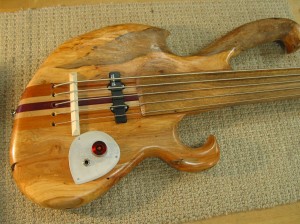
We see a lot of interesting guitars around here, but it’s pretty rare that we see something we’ve truly never seen before. But a customer recently brought in two fretless basses that stopped us in our tracks. How can we describe them? –Unusual? Rough-hewn? Quirky? The woodworking is quite good at times and, um, hurried and homemade looking at others. They seem to be made from a combination of exotic wood species like purple heart and odd driftwood-looking domestics. Both instruments buzzed quite badly and required heavy fretboard leveling. But once that was done, it became evident that the builder had done something right. They actually sounded great and the owner was soon using the 5 string, which he nicknamed “Big Nasty,” in a recording session.
The pricetag for both of these USA handmade instuments? Less than $500 apice! The manufacturer? A North Carolina maker called Wishbass. Take a look at more photos below and see what you think.
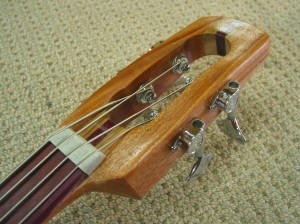
A singe passive pickup is wired directly to a volume pot and output jack.
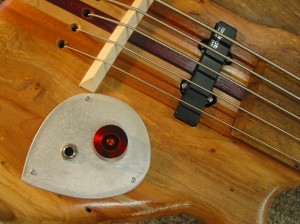
Here’s a second bass, this one a four string model.
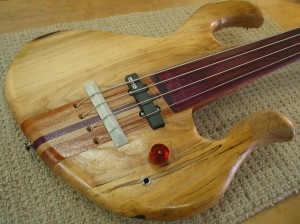
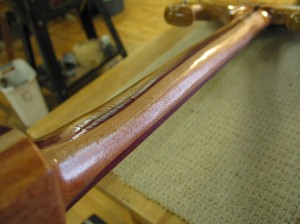
The woodworking is again, hit and miss…
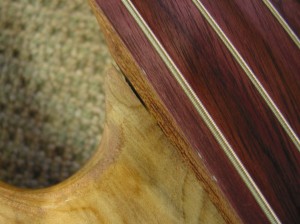
The finish has a drip or two… or three…
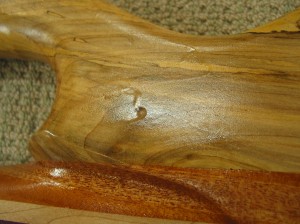
In an era where lots of instruments look the same and most are cranked out by the thousand, these one-of-a-kind basses were kind of refreshing to see. And for the entry-level pricetag, they’re sure to appeal to some. The owner of these two just bought his third on eBay! What do you think?
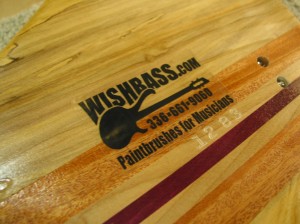

Interesting (weird), alright… Sort of like a cross between an old Danelectro Longhorn and a modern-day Zon bass with an upright headstock.
I have one of his few 40 1/2″ uprights that looks kind of like a pretzel. Nice figured maple and swamp maple with knots in back. Needs sheilding in the cavity to stop the hummmm…
I own one of these bases. I just brought it to a luthier and was advised of the costs to repair it. The neck requires about $100-150 in repairs, all the finishing of the body is another $250-400. So, it is priced for an initial easy purchase, it is unique, it does take time to finish, though. As a novice wood worker, I feel that I could only damage the product and need a pro to take it over. But, at the end of it all, you are guaranteed to have a completely unique bass, made only of wood, and that will be something to look forward to playing.
We’ve now had three of these basses come through our shop and so far, the owners have been concerned with playability only. While we have different standards for our own finish work and while there are definitely globs of shellac and uneven areas on Wishbasses, our customers have decided to live with their appearance. The primary area we’ve been asked to address is the uneven plane of the fingerboard. We have been leveling it as we would in a refret and essentially doing our Works set-up. They’ve all been around or a little less than $100 for that work.
Good point. In the end, the playability of the fretboard is all that I am having done. I am excited to own this bass, as I have been playing the same one since I was 16, and this is the first new instrument I bought in 25 years. Plus, it is really unique, I am helping a guitar maker and a luthier follow their dreams, and supporting the local economy too.
I got involved with Wishbasses back in ’08 when I came across one on Ebay and became intrigued. Since then I have owned over 2 dozen of Steve’s instruments which also includes mandolins, electric/acoustic guitars and electric/acoustic basses. I currently own 13 of his electric basses (11 are fretless – 1 of them has fanned frets, 1 is half fretted & fretless!), 3 of his acoustic basses, 2 mandolins, and 1 acoustic gutar. They are ALL unique, very exotic and a blast to work on and improve. In fact, I have made a hobby and small side business out of refinishing and improving them to the extent I wrote a “WISHBASS REFINSIHING GUIDE” posted within Talkbass.com. Once you get one reworked and set up, there is nothing quite like it. I do consider them an acquired taste but I sure have a good time working on them and am always amazed at how awesome they look and sound after about 30 hours of work! Working on them has also inspired me to learn about making basses myself and I hope to be doing that in 2012. Good for Steve Wishnevsky that he has figured out a way to make a living doing something homemade, homegrown and one-of-a-kind!
Hey, Scott — I’m thinking of having Steve build me an Irish bouzouki, but some of these comments are causing me concern. I don’t have either the woodworking skills, or the budget to have the instrument “finished” once I get it. Any thoughts? Should I just stay away from one of his unless I can afford to have it worked on?
I’ll put in my 2 cents and invite comments from the Wishbass owners. -I think we’ve worked on three so far and all needed work to play nicely. For us, it’s never been more than a couple hours worth of work though. That said, they are solidly built and have a uniquely organic look, feel, and vibe about them. So many instruments are light years from the trees they’re made out of and Steve’s have always made me think of them as a bass made from a tree. They aren’t for everybody, but with some professional attention they can certainly be very playable and unlike anything you’ll find elsewhere.